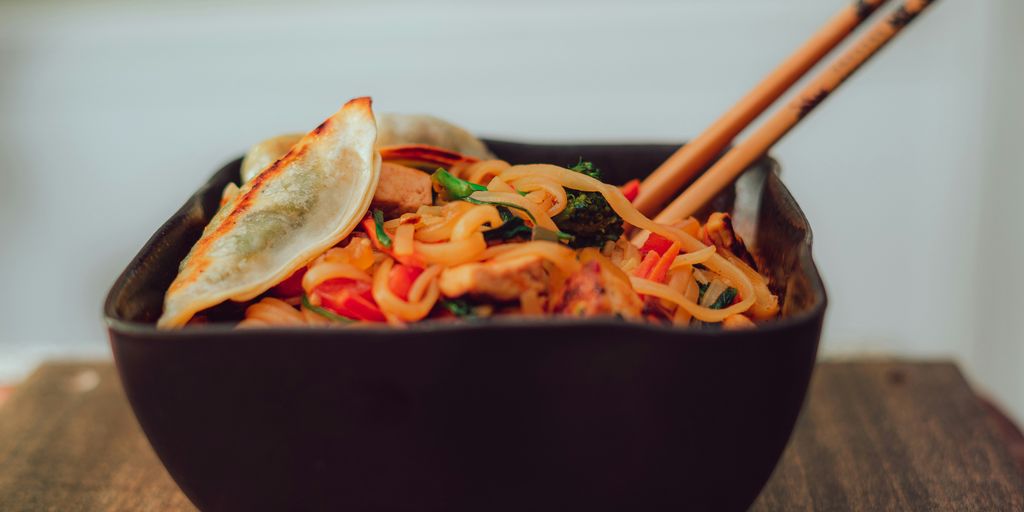Fitness & Wellness
Tips for Perfect Pad Thai: Cooking Thailand’s Famous Dish

Pad Thai is a beloved dish that brings together a variety of flavours and textures, making it a favourite in Thai cuisine. Whether you’re a beginner or an experienced cook, understanding the key elements of making Perfect Pad Thai can elevate your cooking skills and impress your family and friends. Here are some essential tips to help you create this delicious meal at home.
Key Takeaways
- Learn about the history and culture behind Pad Thai to appreciate it more.
- Choose the right rice noodles and fresh ingredients for an authentic taste.
- Master the stir-frying technique to get that smoky flavour.
- Make your own Pad Thai sauce by balancing sweet, sour, and salty tastes.
- Explore different versions of Pad Thai to keep your meals exciting.
Understanding the Origins of Pad Thai
Historical Background of Pad Thai
Pad Thai is a dish that has a rich history. It was created in the 1930s during a time when Thailand was trying to promote national identity. The government encouraged people to eat this noodle dish as a way to unify the country. This dish quickly became popular and is now a staple in Thai cuisine.
Cultural Significance in Thailand
In Thailand, Pad Thai is more than just food; it represents the country’s culture and traditions. It is often served at festivals and celebrations. Many street vendors sell it, making it accessible to everyone. Eating Pad Thai is a way to experience Thai culture firsthand.
Evolution of Pad Thai Over the Years
Over the years, Pad Thai has changed and adapted. Originally, it was made with simple ingredients, but now you can find many variations. Some people add different proteins or vegetables to make it their own. Here are some common changes:
- Adding seafood like shrimp or squid
- Using tofu for a vegetarian option
- Incorporating local vegetables for a fresh taste
Pad Thai is a dish that brings people together, showcasing the flavours and traditions of Thailand.
Overall, understanding the origins of Pad Thai helps us appreciate its place in Thai culture and its journey through history. It is a dish that continues to evolve while remaining a beloved favourite.
Selecting the Right Ingredients for Authenticity

When it comes to making authentic Pad Thai, the ingredients you choose play a crucial role. Here’s how to select the best components for your dish:
Choosing the Best Rice Noodles
- Look for flat rice noodles that are about 3-5 mm wide.
- Check for a soft texture; they should be pliable but not mushy.
- If possible, opt for fresh noodles over dried ones for better flavour.
Essential Proteins for Pad Thai
- Shrimp: A popular choice, offering a sweet and delicate taste.
- Chicken: A versatile option that absorbs flavours well.
- Tofu: Great for vegetarians, providing a nice texture and protein.
Importance of Fresh Vegetables
- Use bean sprouts for crunch and freshness.
- Chives add a mild onion flavour that complements the dish.
- Lime wedges are essential for a zesty finish.
Selecting the right ingredients is key to achieving the authentic taste of Pad Thai. Freshness matters!
Mastering the Art of Stir-Frying
Achieving the Perfect Wok Hei
To create that signature smoky flavour known as Wok Hei, it’s essential to use a well-seasoned wok. Here are some tips to achieve it:
- Preheat the wok: Ensure your wok is hot before adding any ingredients.
- Use high heat: Stir-frying requires high temperatures to sear the ingredients quickly.
- Cook in batches: Avoid overcrowding the wok, as this can lower the temperature and prevent proper cooking.
Balancing Heat and Timing
Timing is crucial in stir-frying. Here’s how to balance heat and timing effectively:
- Prepare all ingredients before starting to cook.
- Add ingredients in stages: Start with proteins, then add vegetables, and finish with noodles.
- Keep stirring: This ensures even cooking and prevents burning.
Common Stir-Frying Mistakes to Avoid
Avoid these common pitfalls to ensure your Pad Thai turns out perfectly:
- Overcooking the noodles: They should be firm yet tender.
- Not using enough oil: This can lead to sticking and uneven cooking.
- Ignoring the order of ingredients: Adding them in the wrong sequence can affect the final taste.
Stir-frying is an art that requires practise. With time, you’ll master the techniques and create delicious dishes that impress everyone!
Crafting the Perfect Pad Thai Sauce

Key Ingredients for the Sauce
To create a delicious Pad Thai sauce, you need to focus on a few key ingredients that bring out the authentic flavours. Here are the essentials:
- Tamarind paste: This gives the sauce its unique sour taste.
- Fish sauce: Adds a salty depth to the dish.
- Palm sugar: Balances the sourness with sweetness.
Balancing Sweet, Sour, and Salty Flavours
The perfect Pad Thai sauce is all about balance. Here’s how to achieve it:
- Start with a base of tamarind paste.
- Gradually add fish sauce to enhance the saltiness.
- Stir in palm sugar until the mixture is sweet but not overpowering.
- Taste and adjust as needed, ensuring all three flavours are present.
Adjusting Spice Levels to Taste
Spice can elevate your Pad Thai sauce. Here’s how to adjust it:
- Add chilli flakes for heat.
- Use fresh chillies for a more intense flavour.
- Remember, it’s easier to add more spice than to take it away, so start small!
Crafting the perfect Pad Thai sauce is an art that requires practise and patience. Experiment with the ingredients to find your ideal balance!
| Ingredient | Amount (for 2 servings) |
|---|---|
| Tamarind paste | 2 tablespoons |
| Fish sauce | 1 tablespoon |
| Palm sugar | 1 tablespoon |
| Chilli flakes | To taste |
By following these guidelines, you can create a Pad Thai sauce that is both authentic and delicious, making your dish truly stand out!
Exploring Traditional and Modern Variations
Classic Pad Thai vs. Modern Twists
Pad Thai is a dish that has evolved over time, with traditional recipes often featuring a balance of flavours and textures. While the classic version is beloved, modern twists have emerged, incorporating new ingredients and techniques. Here are some popular variations:
- Seafood Pad Thai: Uses shrimp, squid, or fish instead of chicken or tofu.
- Pad Thai with a Twist: Includes unique ingredients like mango or avocado for a fresh take.
- Gluten-Free Options: Made with rice noodles and tamari instead of soy sauce.
Incorporating Regional Ingredients
Different regions of Thailand have their own special ingredients that can enhance Pad Thai. Some examples include:
- Northern Thai: Often uses fermented soybeans for a unique flavour.
- Southern Thai: Incorporates coconut and seafood for a richer taste.
- Isaan Style: Adds fresh herbs and spices for a zesty kick.
Vegetarian and Vegan Alternatives
For those who prefer plant-based meals, there are many ways to enjoy Pad Thai without meat. Here are some ideas:
- Tofu Pad Thai: Replace meat with tofu for protein.
- Vegetable Pad Thai: Load up on fresh vegetables like bell peppers, carrots, and bean sprouts.
- Nut-Based Sauces: Use peanut or cashew sauces for added flavour.
Pad Thai is not just a meal; it’s a canvas for creativity. You can mix and match ingredients to suit your taste and dietary needs. Experimenting with flavours can lead to delightful surprises!
Garnishing for Flavour and Aesthetics
Using Fresh Herbs and Peanuts
Garnishing your Pad Thai with fresh herbs and crushed peanuts adds not only flavour but also a delightful crunch. Here are some popular choices:
- Coriander: Adds a fresh, citrusy taste.
- Spring Onions: Provides a mild onion flavour and a pop of colour.
- Crushed Peanuts: Offers a nutty crunch that complements the dish.
The Role of Lime and Chilli
A squeeze of lime and a sprinkle of chilli can elevate your Pad Thai. Here’s how:
- Lime: Enhances the dish with a zesty kick.
- Chilli Flakes: Adds heat and depth to the flavours.
- Chilli Peppers: For those who enjoy a spicy punch, fresh slices can be used.
Presentation Tips for Serving
The way you present your Pad Thai can make a big difference. Consider these tips:
- Use a large, flat plate to showcase the noodles.
- Arrange garnishes neatly on top for a beautiful look.
- Serve with lime wedges on the side for added freshness.
Remember, a well-garnished dish not only looks appealing but also enhances the overall dining experience.
Pairing Pad Thai with Complementary Dishes
When enjoying Pad Thai, it’s great to think about what other dishes can go well with it. Pad Thai is a fantastic stand-alone dish, but pairing it with the right sides can enhance your meal. Here are some ideas:
Traditional Thai Side Dishes
- Spring Rolls: Crispy and filled with vegetables, they add a nice crunch.
- Tom Yum Soup: A spicy and sour soup that complements the flavours of Pad Thai.
- Thai Salad: Fresh and zesty, it balances the richness of the noodles.
Beverage Pairings for Pad Thai
- Thai Iced Tea: Sweet and creamy, it cools down the spice.
- Lemonade: Refreshing and tangy, it pairs well with the dish.
- Beer: A light lager can enhance the flavours without overpowering them.
Desserts to Complete the Meal
- Mango Sticky Rice: A sweet treat that’s a classic in Thai cuisine.
- Coconut Ice Cream: Creamy and refreshing, it’s perfect after a spicy meal.
- Fried Bananas: Crispy on the outside and soft on the inside, they are a delightful end to your meal.
Pairing Pad Thai with complementary dishes not only enhances the flavours but also creates a more enjoyable dining experience. Consider these options to elevate your meal!
Understanding Common Mistakes and How to Avoid Them

Cooking Pad Thai can be tricky, and many people make common mistakes that can ruin the dish. Here are some of the most frequent errors and how to steer clear of them:
Overcooking Noodles
- Noodles should be al dente: Overcooked noodles can become mushy and lose their texture.
- Soak the rice noodles in warm water instead of boiling them to keep them firm.
- Stir-fry quickly to avoid further cooking.
Imbalance of Flavours
- Pad Thai should have a balance of sweet, sour, and salty.
- Taste as you go: Adjust the sauce ingredients gradually to find the right mix.
- Use fresh lime juice and tamarind paste for authentic flavour.
Incorrect Ingredient Proportions
- Measure your ingredients carefully. Too much of one ingredient can overpower the dish.
- Follow a trusted recipe: This helps ensure you get the proportions right.
- Keep a checklist of essential ingredients to avoid missing anything.
Remember, practise makes perfect! The more you cook Pad Thai, the better you will become at avoiding these common mistakes.
Tips for Cooking Pad Thai at Home
Essential Kitchen Tools
To make Pad Thai at home, you’ll need a few key tools:
- Wok: A traditional wok is best for stir-frying.
- Spatula: A flat spatula helps in tossing the noodles.
- Measuring Cups: For accurate ingredient portions.
Time-Saving Techniques
Cooking Pad Thai can be quick if you follow these tips:
- Prep Ingredients Ahead: Chop vegetables and measure sauces before cooking.
- Use Pre-Cooked Proteins: Consider using leftover chicken or shrimp.
- Cook in Batches: If making a large amount, cook in smaller portions for even frying.
Adapting Recipes for Home Cooking
You can easily adjust recipes to suit your taste:
- Swap Ingredients: Use what you have, like different vegetables or proteins.
- Adjust Flavours: If you like it sweeter, add more sugar; for spice, increase the chilli.
- Experiment with Noodles: Try different types of rice noodles or even gluten-free options.
Cooking at home allows you to enjoy authentic flavours while personalising your dish to your liking.
Remember, the key to a great Pad Thai is in the balance of flavours and the freshness of your ingredients. Enjoy the process!
Exploring the Health Benefits of Pad Thai
Pad Thai is not just a delicious dish; it also offers several health benefits. Packed with nutrients, it can be a balanced meal when made with the right ingredients. Here are some key points to consider:
Nutritional Value of Ingredients
- Rice Noodles: A good source of carbohydrates, providing energy.
- Proteins: Chicken, shrimp, or tofu add essential amino acids for muscle repair.
- Vegetables: Fresh veggies like bean sprouts and carrots contribute vitamins and minerals.
Healthier Cooking Methods
- Stir-frying: Quick cooking helps retain nutrients in vegetables.
- Using less oil: Reducing oil can lower calorie content.
- Adding more vegetables: Increases fibre and nutrient intake.
Balancing Indulgence with Nutrition
- Enjoy Pad Thai in moderation to maintain a healthy diet.
- Consider using whole grain noodles for added fibre.
- Experiment with low-sodium sauces to reduce salt intake.
Eating Pad Thai can be a tasty way to enjoy a variety of nutrients, making it a great choice for a balanced meal.
Overall, Pad Thai can be a nutritious option when prepared thoughtfully, allowing you to enjoy its flavours while benefiting your health.
Sourcing Authentic Ingredients Outside Thailand

When trying to make Pad Thai at home, finding the right ingredients can be a challenge, especially if you live far from Thailand. Here are some tips to help you source authentic ingredients:
Finding Specialty Stores
- Asian supermarkets: These stores often carry a wide range of Thai ingredients, including rice noodles and sauces.
- Local markets: Check out farmers’ markets or local shops that focus on international foods.
- Ethnic grocery stores: Many cities have stores that specialise in specific cuisines, which can be a great resource.
Online Shopping Tips
- Research reputable websites: Look for online stores that specialise in Asian ingredients.
- Read reviews: Check customer feedback to ensure quality and service.
- Compare prices: Different sites may offer the same products at varying prices, so shop around.
Substituting Local Ingredients
If you can’t find certain items, consider these substitutions:
- Rice noodles: You can use spaghetti or fettuccine in a pinch, though the texture will differ.
- Fish sauce: Soy sauce can be a good alternative, but it will change the flavour slightly.
- Tofu: Look for extra-firm tofu for the best results in your dish.
Finding the right ingredients is key to making a delicious Pad Thai. Don’t hesitate to experiment with local options if you can’t find the authentic ones!
In Summary
To wrap things up, making the perfect Pad Thai is all about practise and using the right ingredients. Remember to prepare everything before you start cooking, as this will make the process smoother. Don’t be afraid to adjust the flavours to suit your taste, whether that means adding more lime or a bit of spice. With these tips in mind, you’ll be able to create a delicious dish that captures the essence of Thailand right in your own kitchen. Enjoy your cooking adventure!
Frequently Asked Questions
What is the history behind Pad Thai?
Pad Thai has a rich history that dates back to the 1930s when it was promoted as a national dish in Thailand. It combines influences from Chinese stir-fry techniques and local Thai flavours.
What kind of noodles should I use for Pad Thai?
The best noodles for Pad Thai are rice noodles, specifically the flat, wide ones. They soak up the sauce well and give the dish its signature texture.
Can I make Pad Thai vegetarian?
Yes, you can easily make vegetarian Pad Thai by using tofu or vegetables instead of meat. Just ensure you use a vegetarian sauce.
What are the key ingredients for a good Pad Thai sauce?
A tasty Pad Thai sauce usually includes tamarind paste, fish sauce, sugar, and some lime juice. These ingredients create the perfect balance of flavours.
How can I avoid overcooking the noodles?
To prevent overcooking, soak the rice noodles in warm water until they are soft but still firm. Then, stir-fry them quickly to keep their texture.
What should I serve with Pad Thai?
Pad Thai pairs well with traditional Thai sides like spring rolls or a fresh salad. You can also enjoy it with a refreshing drink like iced tea.
Is Pad Thai a healthy meal option?
Pad Thai can be healthy, especially if you use fresh vegetables and lean proteins. Just be mindful of the amount of sauce you use.
Where can I find authentic ingredients for Pad Thai?
You can find authentic ingredients at Asian grocery stores or online. Look for items like tamarind paste and rice noodles to get the best flavours.
-

 Cybersecurity4 days ago
Cybersecurity4 days agoIs Your Privacy at Risk? What You Need to Know About New Data Regulations in 2025
-

 Digital Privacy5 days ago
Digital Privacy5 days agoThe Biggest Data Breaches of 2025 – And How to Protect Yourself
-

 Home & Family7 days ago
Home & Family7 days agoHow Smart Homes Are Transforming the Way We Live in 2025
-

 Technology3 days ago
Technology3 days agoApple, Google, Microsoft: How Big Tech Is Shaping the Future in 2025
-

 Cybersecurity4 days ago
Cybersecurity4 days agoTop 5 Cybersecurity Tips to Keep Your Personal and Business Data Safe in 2025
-

 Blockchain Technology4 days ago
Blockchain Technology4 days agoTech Stocks to Watch: The Biggest IPOs and Market Trends in 2025
-

 Finance6 days ago
Finance6 days agoUS Credit Rating Takes a Hit: Moody’s Downgrades to Aa1 Amid Debt Concerns
-

 Stock Market5 days ago
Stock Market5 days agoU.S. Stock Market Soars as Tariff Cuts Bring Hope for Economic Recovery

















